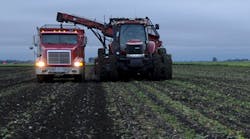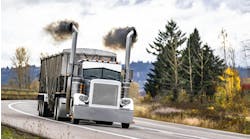Expected to be published officially this week is new guidance from the Federal Motor Carrier Safety Administration (FMCSA) on the 150-air-mile exemption from the Hours of Service (HOS) rules for transporting agricultural commodities. Here's a breakdown of the exemption, how it works and some elucidation from FMCSA on several points of confusion.
WHO: First, as the federal government has defined it, this exemption from the HOS rules—and by extension, having to use an electronic logging device, or ELD—applies to a commercial vehicle driver hauling "any agricultural commodity, nonprocessed food, feed, fiber or livestock . . . including insects."
WHAT: This exemption basically sets up a radius where if the driver hauling agricultural commodities stays within that distance, he or she is exempt from HOS rules. The exemption was expanded six years ago, and as the U.S. Congress wrote it, the radius is "150 air miles." But since we're talking land transportation, that actually works out to 172.5 miles for a truck (an air mile is equal to about 1.15 land mile).
So on the subject of clarity, think of "150 air miles" interchangeably with 172.5 miles of the kind people mean probably 99.99% of the rest of the time the word "mile" is used. The HOS rules don't apply to drivers hauling agricultural commodities within a radius of that distance, and since they don't have to keep logs of their hours, they don't have to use an ELD.
WHATSIT: It turns out there've been some sticking points in how this exemption applies, particularly since ELDs came about—and like other issues, the devices helped bring this one to light. For the first time, FMCSA felt it was necessary to issue guidance on the topic.
The agency "made a couple of key clarifications in the guidance that I think are important to know," said Joe DeLorenzo, director of FMCSA's Office of Compliance and Enforcement, on a call with media prior to the guidance's publication.
Those clarifications include what time or activities the exemption specifically applies to, what the point of origin of the 150-air-mile/ 172.5 land mile radius is, and what happens if the driver transporting ag commodities goes outside of that radius.
What counts?
DeLorenzo explained that essentially all of the time a driver hauling an ag commodity spends within the 172.5 land mile radius is exempt from the HOS rules and recording of driver's logs.
"Any of the time that takes place working within that 150-[air]-mile radius is not counted toward the driver's hours of service," he said. "That includes empty miles driven to a pick-up point, it includes loading time, and it includes the time driving with an agricultural commodity within a 150-[air]-mile radius of the source."
It even goes for a return trip after delivering the load. The exemption "should apply to all portions of a round trip involving agricultural commodities that occur within the 150 -air-mile radius," FMCSA stated in the guidance.
What is the 'source'?
The source is the pick-up point for the agricultural commodity, and it becomes the point from which the 150 air mile/ 172.5 land mile radius is calculated. The source defines the zone where that particular driver can operate and the HOS rules don't apply.
Note that the source in this case doesn't have to be a farm and can be many different types of places. "While a 'source' could be strictly interpreted as a farm or a ranch, it also could be a place where agricultural commodities are aggregated and loaded such as a sale barn or a grain elevator or some other intermediate loading and storage facility where that agricultural product is then loaded onto a truck and transported," DeLorenzo said.
What if there's more than one source?
If a driver transporting agricultural commodities has to travel to multiple locations to pick them up, that's fine—but the first pick-up point is the one that sticks the needle on the map to calculate the 150 air mile/ 172.5 land mile radius to be exempt from HOS rules.
"The guidance is clear that you can have only one source per trip," DeLorenzo emphasized. "This has come up about multiple loading points within a 150-air-mile radius."
"Which one do you use to set the radius?" he added. "Point A is the source; you go there. If you travel to other [loading] points, as long as you're within 150 air miles of the original source, that time doesn't count" and the driver is exempt from the HOS rules.
What happens outside the radius?
If the driver hauling ag commodities crosses the line—that's 150 air miles/ 172.5 land miles from the original pick-up point or source—"the Hours of Service rules kick in starting at zero," DeLorenzo said.
In other words, once that driver crosses outside the radius, it's as if the driver's day has just begun that second in terms of how much time he or she has available to drive, and "you have the full hours of service to go," he pointed out. "That's a fairly significant extension to the workday."
Another important note on this point is that the driver is subject to the HOS rules only while outside that trip's 150-air-mile radius, and is once again exempt from the rules and the requirement to log on-duty hours after crossing back into the radius.
In FMCSA's words in the guidance, when the driver crosses outside the 150-air-mile radius, "the driver would be subject to the HOS rules for the remainder of the trip to the destination." But on the way back after having delivered the goods, "the driver would be subject to the HOS rules until returning within the 150-air-mile radius in which the trip began."
Do I have to use an ELD outside the radius?
Not necessarily. Yes, should the commercial vehicle driver transporting ag commodities go outside the 150 air mile/ 172.5 land mile working radius, the driver is then subject to the federal HOS rules and must record his or her hours of service.
But here's a key point: there's an ELD exemption that could apply. If a driver is required to record hours of service no more than eight out of any given 30 calendar days, the driver doesn't have to use an ELD and can choose to use paper logs.
That's not a monthly measure, it's simply a rolling 30-day period and is specific by driver. So if a particular driver transporting ag commodities goes outside of the 150 air mile/ 172.5 land mile working radius on eight or fewer days in any given 30-day period, that driver can record his or her time on paper logs and doesn't need to get an ELD.
Go to https://www.fmcsa.dot.gov/sites/fmcsa.dot.gov/files/docs/regulations/404431/agricultural-commodity-transportation-guidance.pdf to read FMCSA's complete guidance.



